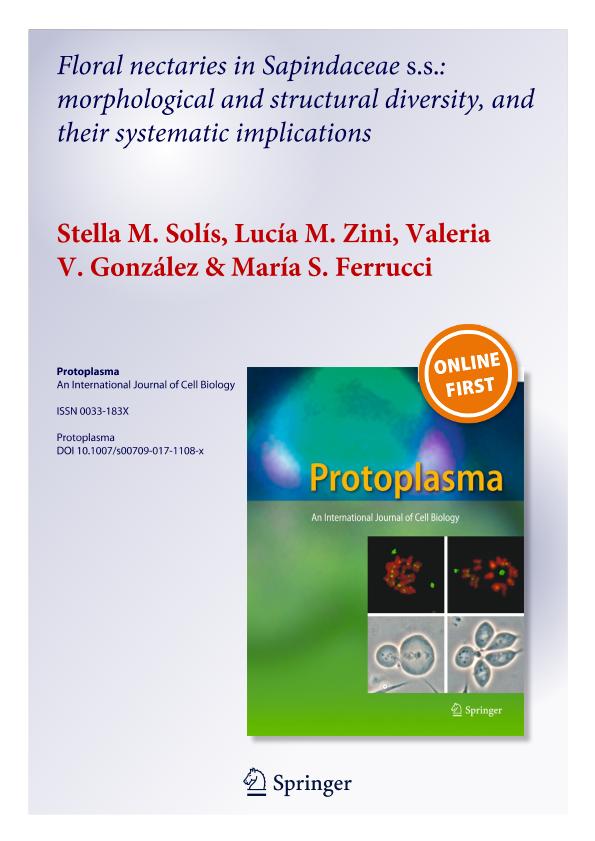Mostrar el registro sencillo del ítem
dc.contributor.author
Solis, Stella Maris

dc.contributor.author
Zini, Lucia Melisa

dc.contributor.author
González, Valeria Vanesa

dc.contributor.author
Ferrucci, María Silvia

dc.date.available
2018-11-01T19:49:55Z
dc.date.issued
2017-04
dc.identifier.citation
Solis, Stella Maris; Zini, Lucia Melisa; González, Valeria Vanesa; Ferrucci, María Silvia; Floral nectaries in Sapindaceae s.s.: morphological and structural diversity, and their systematic implications; Springer Wien; Protoplasma; 254; 6; 4-2017; 2169-2188
dc.identifier.issn
0033-183X
dc.identifier.uri
http://hdl.handle.net/11336/63495
dc.description.abstract
We investigated the morphology and structure of the floral nectary in 11 Neotropical genera belonging to the subfamilies Dodonaeoideae and Paullinioideae (Sapindaceae) from southern South America representing three tribes (Dodonaeaeae, Paullinieae, and Melicocceae), in relation to other floral traits in species with contrasting morphological flower characteristics. Nectary organization was analyzed under light, stereoscopic, and scanning electron microscopes; Diplokeleba floribunda N.E. Br. was also observed using transmission electron microscopy. Our comparative data may contribute to the understanding of floral nectary evolution and systematic value in this family. The nectaries were studied in both staminate and pistillate flowers. All the floral nectaries are typical of Sapindaceae: extrastaminal, receptacular, structured, and persistent. The anatomical analysis revealed a differentiated secretory parenchyma and an inner non-secretory parenchyma; the nectary is supplied by phloem traces and, less frequently, by phloem and xylem traces. Nectar is secreted through nectarostomata of anomocytic type. The anatomical analysis showed the absence of nectary in the three morphs of Dodonaea viscosa flowers. Nectary ultrastructure is described in D. floribunda. In this species, the change in nectary color is related to progressive accumulation of anthocyanins during the functional phase. We found relatively small variation in the nectary structural characteristics compared with large variation in nectary morphology. The latter aspect agreed with the main infrafamilial groupings revealed by recent phylogenetic studies, so it is of current valuable systematic importance for Sapindaceae. In representatives of Paullinieae, the reduction of the floral nectary to 4–2 posterior lobes should be interpreted as a derived character state.
dc.format
application/pdf
dc.language.iso
eng
dc.publisher
Springer Wien

dc.rights
info:eu-repo/semantics/openAccess
dc.rights.uri
https://creativecommons.org/licenses/by-nc-sa/2.5/ar/
dc.subject
Color Change
dc.subject
Morphology
dc.subject
Nectarostomata
dc.subject
Sapindaceae Floral Nectary
dc.subject
Structure
dc.subject.classification
Ciencias de las Plantas, Botánica

dc.subject.classification
Ciencias Biológicas

dc.subject.classification
CIENCIAS NATURALES Y EXACTAS

dc.title
Floral nectaries in Sapindaceae s.s.: morphological and structural diversity, and their systematic implications
dc.type
info:eu-repo/semantics/article
dc.type
info:ar-repo/semantics/artículo
dc.type
info:eu-repo/semantics/publishedVersion
dc.date.updated
2018-10-23T16:22:46Z
dc.journal.volume
254
dc.journal.number
6
dc.journal.pagination
2169-2188
dc.journal.pais
Austria

dc.journal.ciudad
Viena
dc.description.fil
Fil: Solis, Stella Maris. Universidad Nacional del Nordeste. Facultad de Ciencias Exactas y Naturales y Agrimensura; Argentina
dc.description.fil
Fil: Zini, Lucia Melisa. Consejo Nacional de Investigaciones Científicas y Técnicas. Centro Científico Tecnológico Conicet - Nordeste. Instituto de Botánica del Nordeste. Universidad Nacional del Nordeste. Facultad de Ciencias Agrarias. Instituto de Botánica del Nordeste; Argentina
dc.description.fil
Fil: González, Valeria Vanesa. Consejo Nacional de Investigaciones Científicas y Técnicas. Centro Científico Tecnológico Conicet - Nordeste. Instituto de Botánica del Nordeste. Universidad Nacional del Nordeste. Facultad de Ciencias Agrarias. Instituto de Botánica del Nordeste; Argentina
dc.description.fil
Fil: Ferrucci, María Silvia. Consejo Nacional de Investigaciones Científicas y Técnicas. Centro Científico Tecnológico Conicet - Nordeste. Instituto de Botánica del Nordeste. Universidad Nacional del Nordeste. Facultad de Ciencias Agrarias. Instituto de Botánica del Nordeste; Argentina
dc.journal.title
Protoplasma

dc.relation.alternativeid
info:eu-repo/semantics/altIdentifier/url/https://link.springer.com/article/10.1007%2Fs00709-017-1108-x
dc.relation.alternativeid
info:eu-repo/semantics/altIdentifier/doi/http://dx.doi.org/10.1007/s00709-017-1108-x
Archivos asociados
